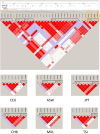LINGO1 rs9652490 and rs11856808 polymorphisms are not associated with risk for multiple sclerosis
- PMID: 23574883
- PMCID: PMC3636038
- DOI: 10.1186/1471-2377-13-34
LINGO1 rs9652490 and rs11856808 polymorphisms are not associated with risk for multiple sclerosis
Abstract
Background: Some recent experimental data suggest a possible role of LINGO-1 in the pathogenesis of multiple sclerosis (MS). In an attempt to identify genetic biomarkers related to MS susceptibility, we genotyped two common SNPs in the LINGO1 gene which have been associated to other neurological conditions, in patients with MS and in healthy subjects. These SNPs are linked to several SNPs within the LINGO1 gene, especially in individuals of Oriental or Caucasian descent.
Methods: We analyzed the allelic and genotype frequency of two LINGO1 variants (rs9652490 and rs11856808) in 293 patients with MS and 318 healthy controls, using KASPar assays.
Results: LINGO1 rs9652490 and rs11856808 allelic and genotype frequencies did not differ significantly between MS patients and controls. The minor allele frequencies for rs9652490 were 0.171 (95% CI = 0.140-0.201) and 0.167 (95% CI = 0.138-0.196 for cases and controls respectively (p = 0.853). For rs11856808 the minor allele frequencies were 0.317 (95% CI = 0.280-0.355) and 0.310 (95% CI = 0.274-0.346) for cases and controls, respectively (p = 0.773). Allele and genotype frequencies were unrelated with the age of onset of MS, gender, and clinical course of MS. In addition, haplotype analyses did not reveal any putative risk related to haplotypes.
Conclusions: These results suggest that LINGO1 rs9652490 and rs11856808 polymorphisms are not related with risk for MS. This study adds to other published evidence indicating that, to date, the LINGO1 SNPs studied here could be useful risk biomarkers of developing essential tremor, but not other movement disorders.
Figures

Similar articles
-
LINGO1 and risk for essential tremor: results of a meta-analysis of rs9652490 and rs11856808.J Neurol Sci. 2012 Jun 15;317(1-2):52-7. doi: 10.1016/j.jns.2012.02.030. Epub 2012 Mar 17. J Neurol Sci. 2012. PMID: 22425540
-
Lack of association of LINGO1 rs9652490 and rs11856808 SNPs with familial essential tremor.Eur J Neurol. 2011 Aug;18(8):1085-9. doi: 10.1111/j.1468-1331.2010.03251.x. Epub 2010 Nov 18. Eur J Neurol. 2011. PMID: 21219542
-
Role of LINGO1 polymorphisms in Parkinson's disease.Mov Disord. 2009 Dec 15;24(16):2404-7. doi: 10.1002/mds.22768. Mov Disord. 2009. PMID: 19908305 Free PMC article.
-
LINGO1 variants in essential tremor and Parkinson's disease.Acta Neurol Scand. 2012 Jan;125(1):1-7. doi: 10.1111/j.1600-0404.2011.01516.x. Epub 2011 Apr 7. Acta Neurol Scand. 2012. PMID: 21470193 Review.
-
The potential of LINGO-1 as a therapeutic target for essential tremor.Expert Opin Ther Targets. 2015;19(8):1139-48. doi: 10.1517/14728222.2015.1028360. Epub 2015 Apr 10. Expert Opin Ther Targets. 2015. PMID: 25862159 Review.
Cited by
-
Association between LAG3/CD4 Genes Variants and Risk for Multiple Sclerosis.Int J Mol Sci. 2022 Dec 3;23(23):15244. doi: 10.3390/ijms232315244. Int J Mol Sci. 2022. PMID: 36499569 Free PMC article.
-
Heme Oxygenase-1 and 2 Common Genetic Variants and Risk for Multiple Sclerosis.Sci Rep. 2016 Feb 12;6:20830. doi: 10.1038/srep20830. Sci Rep. 2016. PMID: 26868429 Free PMC article.
-
NQO1 gene rs1800566 variant is not associated with risk for multiple sclerosis.BMC Neurol. 2014 Apr 23;14:87. doi: 10.1186/1471-2377-14-87. BMC Neurol. 2014. PMID: 24755231 Free PMC article.
-
Genetic and Epigenetic Regulation in Lingo-1: Effects on Cognitive Function and White Matter Microstructure in a Case-Control Study for Schizophrenia.Int J Mol Sci. 2023 Oct 26;24(21):15624. doi: 10.3390/ijms242115624. Int J Mol Sci. 2023. PMID: 37958608 Free PMC article.
References
-
- Ramagopalan SV, Deluca GC, Degenhardt A, Ebers GC. The genetics of clinical outcome in multiple sclerosis. J Neuroimmunol. 2008;201–202:183–199. - PubMed
-
- Pugliatti M, Harbo HF, Holmoy T, Kampman MT, Myhr KM, Riise T, Wolfson C. Environmental risk factors in multiple sclerosis. Acta Neurol Scand Suppl. 2008;188:34–40. - PubMed
Publication types
MeSH terms
Substances
LinkOut - more resources
Full Text Sources
Other Literature Sources
Medical

